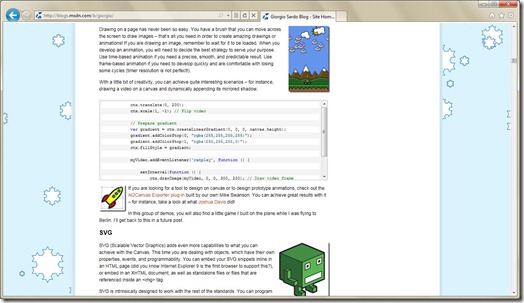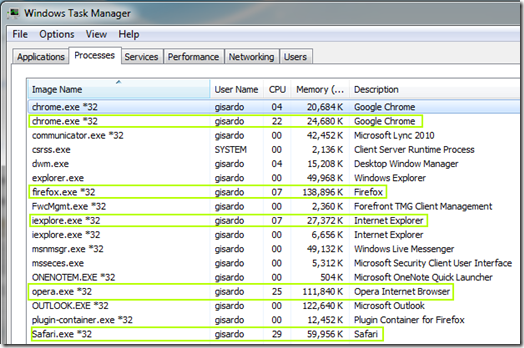HTML5 Snow falling on my blog
Based on an interesting script of David Flanagan to generate a snow flake using recursive JavaScript and HTML5 <canvas>, I had some fun during the weekend and added some snow to my blog.![]()
David’s implementation is based on several canvas elements (one for each snow flake) added to the DOM tree and animated using CSS. I preferred to create only one Canvas and animate all the flakes inside it. To avoid the Canvas to block the interaction with the page I added it as an element with background priority.
(function () {
// Start Animation only if browser support <canvas>
if (document.createElement('canvas').getContext) {
if (document.readyState === 'complete')
Snow();
else
window.addEventListener('DOMContentLoaded', Snow, false);
}
var deg = Math.PI / 180; // For converting degrees to radians
var sqrt3_2 = Math.sqrt(3) / 2; // Height of an equilateral triangle
var flakes = []; // Things that are dropping
var scrollspeed = 64; // How often we animate things
var snowspeed = 500; // How often we add a new snowflake
var maxflakes = 20; // Max number of flakes to be added at the same time
var rand = function (n) { return Math.floor(n * Math.random()); }
var canvas, sky;
var snowingTimer;
var invalidateMeasure = false;
function Snow() {
canvas = document.createElement('canvas');
canvas.style.position = 'fixed';
canvas.style.top = '0px';
canvas.style.left = '0px';
canvas.style.zIndex = '0';
document.body.insertBefore(canvas, document.body.firstChild);
sky = canvas.getContext('2d');
ResetCanvas();
snowingTimer = setInterval(createSnowflake, snowspeed);
setInterval(moveSnowflakes, scrollspeed);
window.addEventListener('resize', ResetCanvas, false);
}
function ResetCanvas() {
invalidateMeasure = true;
canvas.width = document.body.offsetWidth;
canvas.height = window.innerHeight;
sky.strokeStyle = '#0066CC';
sky.fillStyle = 'white';
}
function drawFlake(x, y, size, order) {
sky.save();
sky.translate(x, y);
snowflake(order, 0, Math.floor(sqrt3_2 * y), size);
sky.fill();
sky.stroke();
sky.restore();
}
function snowflake(n, x, y, len) {
sky.save(); // Save current transformation
sky.beginPath();
sky.translate(x, y); // Translate to starting point
sky.moveTo(0, 0); // Begin a new subpath there
leg(n); // Draw the first leg of the fractal
sky.rotate(-120 * deg); // Rotate 120 degrees anticlockwise
leg(n); // Draw the second leg
sky.rotate(-120 * deg); // Rotate again.
leg(n); // Draw the final leg
sky.closePath(); // Close the subpath
sky.restore(); // Restore original transformation
// Draw a single leg of a level-n Koch snowflake.
// This function leaves the current point at the end of
// the leg it has drawn and translates the coordinate
// system so the current point is (0,0). This means you
// can easily call rotate() after drawing a leg.
function leg(n) {
sky.save(); // Save current transform
if (n == 0) { // Non-recursive case:
sky.lineTo(len, 0); // Just a horizontal line
}
else { // Recursive case: _ _
// draw 4 sub-legs like: \/
sky.scale(1 / 3, 1 / 3); // Sub-legs are 1/3rd size
leg(n - 1); // Draw the first sub-leg
sky.rotate(60 * deg); // Turn 60 degrees clockwise
leg(n - 1); // Draw the second sub-leg
sky.rotate(-120 * deg); // Rotate 120 degrees back
leg(n - 1); // Third sub-leg
sky.rotate(60 * deg); // Back to original heading
leg(n - 1); // Final sub-leg
}
sky.restore(); // Restore the transform
sky.translate(len, 0); // Translate to end of leg
}
}
function createSnowflake() {
var order = 2;
var size = 10 + rand(90);
var t = (document.body.offsetWidth - 964) / 2;
var x = (rand(2) == 0) ? rand(t) : t + 964 + rand(t); // Make it fit with my blog
var y = window.pageYOffset;
flakes.push({ x: x, y: y, vx: 0, vy: 3 + rand(3), size: size, order: order });
if (flakes.length > maxflakes) clearInterval(snowingTimer);
}
function moveSnowflakes() {
sky.clearRect(0, 0, canvas.width, canvas.height);
var maxy = canvas.height;
for (var i = 0; i < flakes.length; i++) {
var flake = flakes[i];
flake.y += flake.vy;
flake.x += flake.vx;
if (flake.y > maxy) flake.y = 0;
if (invalidateMeasure) {
var t = (canvas.width - 964) / 2;
flake.x = (rand(2) == 0) ? rand(t) : t + 964 + rand(t);
}
drawFlake(flake.x, flake.y, flake.size, flake.order);
// Sometimes change the sideways velocity
if (rand(4) == 1) flake.vx += (rand(11) - 5) / 10;
if (flake.vx > 2) flake.vx = 2;
if (flake.vx < -2) flake.vx = -2;
}
if (invalidateMeasure) invalidateMeasure = false;
}
} ());
I did a quick test check with performance, and it looks like IE9 perform better with CPU/Memory usage (IE9 Beta Refresh, Firefox 4 Beta7, Chrome 10 Canary, Opera 11Beta and Safari 5).
You can find the original script from David here, the script with my updates here.
Happy Holidays! ![]()
Comments
- Anonymous
December 14, 2010
I like how you've used the snowflakes in the background. I've finally responded to your comments here: www.davidflanagan.com/.../let-it-snow.html

